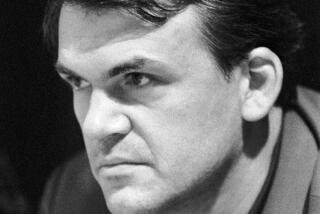BOOK REVIEW : An Intimate Look at an India in Decay : THE GREAT INDIAN NOVEL<i> By Shashi Tharoor</i> Arcade Publishing $19.95, 432 pages
- Share via
Shashi Tharoor’s title, “The Great Indian Novel,” much as the structure of the book that follows, has been taken from India’s national epic, “The Mahabharata.” In Sanskrit, “Maha” means great; “Bharata” means India. I have to agree with the author’s choice of title. To have called this book “The Mahabharata Novel” would have been an egregious affront to one of the great works of world literature.
“The Great Indian Novel” is a told tale. The narrator’s name is Ved Vyas, though often he is addressed as V. V. and sometimes by the honorific V. V. ji . An old man, he dictates his story to a south Indian secretary of big nose and elephantine tread whose name is Ganapathi.
The Mahabharata, if you can’t guess already, is narrated by Vyas. His secretary is none other than Ganesh, the elephant-headed god who looks over writers and their kind. In his guise as celestial secretary, Ganesh is known as Ganapathi. Get it?
If you took all the spiritual and moral precepts and teachings on conduct from all the religions, from Kalihari animists on through to Georgia Baptists, and squeezed them together like a lump of coal, the diamond you produced would have one name: dharma . To call dharma a code of good conduct, or to think of it as a matter of always doing the right thing, or to speak of it as duty, is not saying enough. The entire Mahabharata presents the complexities of what dharma means.
In fact the only thing in the modern world that could even come close to the complexities incurred by the mere consideration of dharma is probably Indian politics, and that is what Shashi Tharoor has taken on. His task, as they say on the streets, is “epic.”
Ved Vyas has seen it all in his 88 years, from the golden days of the British Raj to the first public protests led by Gandhi to the battle for Indian freedom from England to the carnage of separation to the internecine political squabbling that peaked when Indira Gandhi, as prime minister, assumed special powers and had her opposition arrested. Ved Vyas was somehow present for nearly every conversation of consequence in the rise of modern India and, in “The Great Indian Novel,” he tells all to Ganapathi and the reader listens in.
Of course, this being a novel and this being a novel loosely based on the Mahabharata, Gandhi goes by the name of Ganga Data, and Indira Gandhi as Priya Duryodhani. Dhritarashtra, the blind king of the Mahabharata, stands in for Nehru in this novel. Georgina Drewpad is stand-in for Lady Mountbatten (who did in fact have an affair with Nehru).
Consider some of the titles of the 18 books of “The Great Indian Novel”: “The Duel With the Crown,” “A Raj Quartet,” “The Son Also Rises,” “Midnight’s Parents,” “Darkness at Dawn,” “The Man Who Could Not Be King,” “Passages Through India,” “The Rigged Veda,” “The Bungle Book.” Get it? The author revels in such indulgences. (I think of it as a bad British habit.) There should be a concordance for this book, to help the reader wade through all the puns and the like. The wordplay and the drone of the narrator’s voice telling me everything, explaining everything, became very wearing.
But I slogged on, right to the end. And when I was finished, I was sad to see it go.
Shashi Tharoor has made me look at the rise of modern India through Indian eyes. In the beginning of the book, Ved Vyas says, “India is not an underdeveloped country but a highly developed one in an advanced state of decay.” By the end of this novel even those who never have been to India can understand those lines in an intimate way.
Next: Elaine Kendall reviews “My Life With Darwin” by Molly Beth Tinsley (Houghton-Mifflin).
More to Read
Sign up for our Book Club newsletter
Get the latest news, events and more from the Los Angeles Times Book Club, and help us get L.A. reading and talking.
You may occasionally receive promotional content from the Los Angeles Times.










